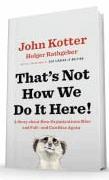Outside Perspectives On Change
By Pat Cormier, managing director, Kotter International
Tackling Transformations In Highly Regulated Industries
 Organizations everywhere aspire to create a pipeline of persuasive leaders who will help drive their business to the next level. Cultivating this kind of talent presents challenges — even more so when you need leaders who can steer the organization through uncharted waters and help it adapt to change. Within the life sciences sector, regulation brings a host of additional roadblocks; leaders have to be better equipped than ever to overcome the challenges.
Organizations everywhere aspire to create a pipeline of persuasive leaders who will help drive their business to the next level. Cultivating this kind of talent presents challenges — even more so when you need leaders who can steer the organization through uncharted waters and help it adapt to change. Within the life sciences sector, regulation brings a host of additional roadblocks; leaders have to be better equipped than ever to overcome the challenges.
Most organizations struggle to overcome the organizational inertia around change, adapting internal process to external realities and building buy in. Within highly regulated industries, change is often accompanied by the looming threat of legal ramifications, if handled incorrectly. In too many cases, this danger alone introduces the dreaded “compliance” question, which often shuts down any meaningful change effort before it even begins.
When it comes to change, leaders in life sciences must overcome regulatory, cultural, language, and process challenges to adapt to a world that’s evolving faster every day. But it’s not an insurmountable task. There are some simple concepts leaders can use to empower themselves and their teams to tackle change, even within the confines of the environment:
- APPROACH CHANGE AS AN OUTSIDER
Leaders need to step outside their industry and role, leaving the typical playbook behind in order to frame the need for change and the opportunities change will present within a highly regulated environment. Taking an outside perspective requires leaders to question the messages they are delivering around change and ask how they are being perceived by the intended audience. Instead of asking, “How can we do this better?”, try asking, “Why do we do it this way to begin with, and is there a better way to achieve the desired result?” - KEEP TERMS SIMPLE AND CLEAR
One of the most pervasive barriers to tackling change in any industry — but particularly in regulated sectors — is the language used to discuss alternate ways of working. Terms such as “regulation” and “noncompliant” provide natural barriers to change and eventually cut off questioning existing processes altogether. Organizations need to come to an understanding around corporate language, such as whether “compliance” refers to compliance with laws or with internal policies, in order to determine how to accurately and clearly frame the opportunity in pursuing a change agenda. - PURPOSEFULLY BUILD TEAMS OF DIVERSE PERSPECTIVES
While change initiatives invariably need input from the organization’s top experts, teams composed solely of experts can be limited in their thinking, confined mainly to improving upon “business as usual.” Teams that incorporate minds from all levels and backgrounds, across departments, and even geographies, however, can enable life science change leaders to inject new perspectives into the conversation, challenging basic assumptions and yielding very creative solutions.
Whether tackling transformation in medical device manufacturing processes or forging more collaborative relationships within pharmaceutical sales channels, implementing change within regulated industries requires a focused and deliberative effort. Leaders who approach change from an outside perspective, using clear and simple terminology and with support from diverse teams, are most likely to see their transformation efforts succeed.

